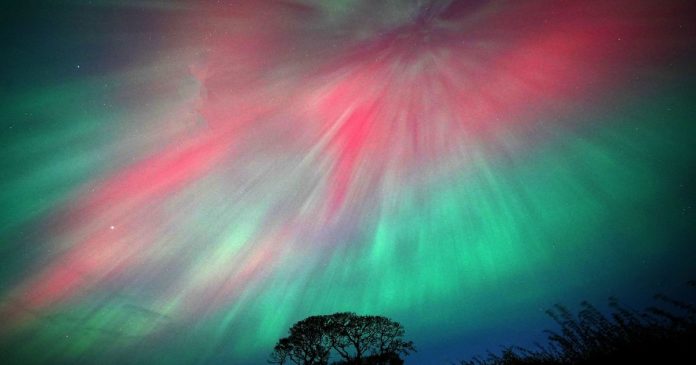Skywatchers have been urged to keep an eye on the night’s sky as a red alert has been issued for the Northern Lights.
People in the far north of the country have been told to keep an eye out for the beautiful phenomenon, usually seen over the likes of Iceland, Canada, Norway and Finland. Given the right conditions however, an aurora borealis can be seen further south to Europe and last night the Earth was hit by a powerful coronal mass ejection. A red alert has been put out by AuroraWatch UK, meaning a sighting is highly likely – as long as the sky remains clear and not too cloudy.
Though the peak of the activity was last night, the Met Office has said those in certain parts of the UK could continue to see activity tonight, including Scotland and the north. The forecaster’s Northern Hemisphere aurora forecast sys: “A coronal mass ejection (CME) arrived at Earth in the late afteroon on April 15.
“Its associated effects may continue into Wednesday night and may bring aurora to far northern parts of the UK and similar geomagnetic latitudes. The auroral oval will ease to background levels thereafter.”
The Northern Lights are caused by huge explosions of activity from the Sun that throw out large amounts of charged particles in space, called solar wind. These giant explosions on the Sun are what’s called coronal mass ejections, which see particles flying away from the Sun at approximately one million miles per hour, according to the Met Office.
Last year experts said there could be more sightings of the Northern Lights in 2025. Elizabeth J McGrath, from Colby College, said: “The sun has been very active recently, and we expect it to continue through 2025.
“Normally we only see the aurora at locations close to Earth’s magnetic north and south poles because charged particles from the sun get trapped by the Earth’s magnetic field and funnelled to the poles.
“With stronger solar storms during solar maximum, there are more charged particles from the sun, and when these particles interact with Earth’s magnetic field, they can be distributed farther from Earth’s north and south magnetic poles, reaching more southerly latitudes here on Earth.”
Get email updates with the day’s biggest stories


